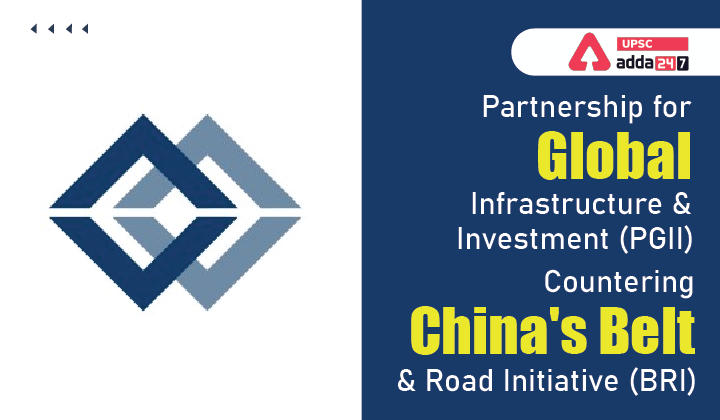Table of Contents
Partnership for Global Infrastructure and Investment (PGII)- Relevance for UPSC Exam
Partnership for Global Infrastructure and Investment (PGII): PGII was recently launched by G7 countries at G7 Summit 2022. Partnership for Global Infrastructure and Investment (PGII) is important for UPSC Mains GS Paper 2 (International Relations- Effect of policies and politics of developed and developing countries on India’s interests).
Partnership for Global Infrastructure and Investment (PGII) in News
- Recently, U.S. President Joe Biden along with his G7 allies unveiled the Partnership for Global Infrastructure and Investment (PGII), largely seen as a counter to China’s multi-trillion dollar Belt and Road Initiative (BRI).
Partnership for Global Infrastructure and Investment (PGII)
- About: The Partnership for Global Infrastructure and Investment (PGII) was launched by G7 countries to aid lower and middle-income countries in building better infrastructure.
- The Partnership for Global Infrastructure and Investment (PGII) was first unveiled by the G7 leadership in June 2021.
- Mandate: PGII aims to collectively mobilise funds to invest in sustainable and quality infrastructure projects in developing countries, including India, and strengthen global supply chains.
- Four Priority Pillars of PGII: All PGII projects will be driven by “four priority pillars that will define the second half of the 21st century”.
- Tackling the climate crisis and ensuring global energy security,
- Bolstering digital information and ICT networks,
- Promoting gender equality and equity, and
- Build and upgrade the global health infrastructure.
- Funding: A funding of $600 billion by 2027 would be mobilized by the G7member countries towards developing sustainable infrastructure and reliable global supply chain.
- USA has pledged to channel $200 billion in grants, public financing, and private capital over the next five years for the PGII.
- European Commission President Ursula von der Leyen declared Europe’s pledge of mobilising 300 billion euros for the partnership over the same period.
PGII Projects in India
- A PGII project has already been announced in India but India had opted out of China’s BRI, being wary of Beijing’s aim to increase its influence in the Indian Ocean Region by roping in Pakistan as a major BRI recipient.
- In India, the U.S. DFC will invest up to $30 million in Omnivore Agritech and Climate Sustainability Fund 3.
- Omnivore Agri-tech and Climate Sustainability Fund 3 is an impact venture capital fund that invests in entrepreneurs building the future of agriculture, food systems, climate, and rural economy in India.
Partnership for Global Infrastructure and Investment
China’s BRI and G7’s PGII- A Comparative Analysis
- About BRI: The Belt and Road project was started to revive connectivity, trade, and infrastructure along what was China’s ancient Silk Road.
- China had announced a two-pronged approach of building a Silk Road Economic Belt on Land and a maritime 21st century Silk Road.
- The project initially aimed to strengthen connectivity with Southeast Asia but later expanded to South and Central Asia, Africa, Europe, and Latin America.
- About PGII: The G7 meanwhile has specifically touted the PGII as a values-based plan to help underfunded low and middle-income countries meet their infrastructure needs.
- Focus on Sustainable Infrastructure: PGII has laid focus on climate action and clean energy, while China has built large coal-fired plants under BRI along with solar, hydro, and wind energy projects.
- Funding Mechanism: While the G7 has pledged $600 billion by 2027, Morgan and Stanly estimate that China’s overall funding for BRI by that time could reach $1.2 to 1.3 trillion dollars with the actual funding being higher.
- Under the PGII, large private capital will be also mobilised while China’s BRI is majorly state-funded.
- Transparency Concerns: While G7 leaders emphasised ‘transparency’ as the cornerstone of PGII projects, the BRI has faced criticism for making countries sign confidential tenders for extending massive loans, leaving countries indebted to China.
- For instance, after the BRI’s flagship $62 billion China-Pakistan Economic Corridor, Pakistan owes Beijing a large proportion of its foreign debt.
Read current affairs for UPSC




 TSPSC Group 1 Question Paper 2024, Downl...
TSPSC Group 1 Question Paper 2024, Downl...
 TSPSC Group 1 Answer key 2024 Out, Downl...
TSPSC Group 1 Answer key 2024 Out, Downl...
 UPSC Prelims 2024 Question Paper, Downlo...
UPSC Prelims 2024 Question Paper, Downlo...




